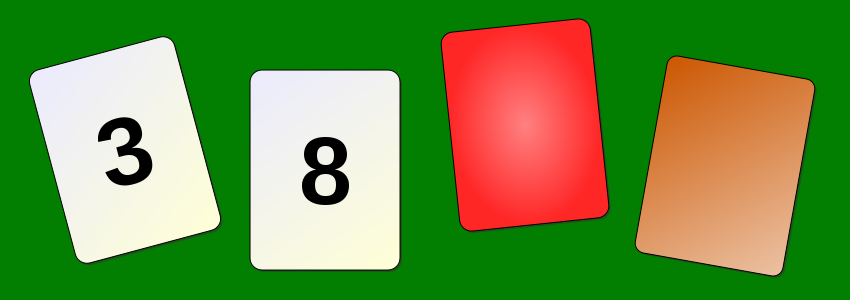The four-card problem (also known as the Wason selection task) is a logic puzzle devised by Peter Cathcart Wason in 1966. It is one of the most famous tasks in the study of deductive reasoning1. The most common description of the task goes as follows. There is a set of four cards placed on a table, each of which has a number on one side and a colored patch on the other side. Which card(s) must be turned over in order to test the truth of the proposition that if a card shows an even number on one face, then its opposite face is red?

A response that identifies a card that need not be inverted, or that fails to identify a card that needs to be inverted, is incorrect. The correct response is to turn over only the 8 and brown cards. The rule was "if the card shows an even number on one face, then its opposite face is red". Only a card with both an even number on one face and something other than red on the other face can invalidate this rule:
-
if the 3 card is red (or brown), that doesn't violate the rule
-
if the 8 card is not red, that violates the rule
-
if the red card is odd (or even), that doesn't violate the rule
-
if the brown card is even, that violates the rule
In Wason's study, not even 10% of subjects found the correct solution. This result was replicated in 1993. An interesting property of this puzzle is that subjects usually have no problem understanding the logical solution when it is explained to them, and that they immediately agree that it is the correct solution.
Evolutionary psychologists Leda Cosmides and John Tooby identified in 1992 that the selection task tends to produce the correct response when presented in a context of social relations. For example, if the rule used is "If you are drinking alcohol then you must be over 18", and the cards have an age on one side and beverage on the other, e.g., "16", "drinking beer", "25", "drinking coke", most people have no difficulty in selecting the correct cards ("16" and "beer"). This seems to support the idea that our facility for such tasks evolved to catch cheaters in a social environment.
Input
The first two lines of the input describe a Wason card. The first line describes which side of the card can be seen: color or value. If the colored patch can be seen, its color is described on the second line. Otherwise the second line contains an integer. The third line contains either yes or no as someone's response to the question whether or not the card must be turned over to test the idea that if a card shows an even number on one face, then its opposite face is red.
Output
The output contains a sentence that describes whether or not the person has correctly solved the Warson card task. Derive the possible variations of the sentence from the examples given below.
Example
Input:
value
3
yesOutput:
Wrong: cards with value 3 must not be turned.Example
Input:
value 8 yes
Output:
Correct: cards with value 8 must be turned.
Example
Input:
color red no
Output:
Correct: cards with color red must not be turned.
Example
Input:
color brown no
Output:
Wrong: cards with color brown must be turned.
Resources
-
Cosmides L, Tooby J (1992). Cognitive adaptations for social exchange. The adapted mind: Evolutionary psychology and the generation of culture 163, 163–228.
-
Wason PC (1966). Reasoning. In New horizons in psychology, Harmondsworth: Penguin.